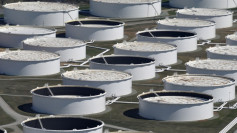Manufacturing production in the United States is showing more signs of life, rising unexpectedly by 0.6 percent in August after falling 0.4 percent in July, according to the U.S. Federal Reserve.
The Fed said the slight uptick was due to a surge in machinery and primary metals production. Manufacturing accounts for 11 percent of the U.S. GDP.
Capacity utilization was also up. It rose to 75.7 percent in August from 75.4 percent in July. Overall capacity use for the industrial sector improved to 77.9 percent from 77.5 percent in July.
Capacity utilization measures how fully firms or a country are using their manufacturing and production capabilities in a given time frame. The Fed looks at capacity utilization for signals of how much "slack" remains in the U.S. economy and how far growth can go before it becomes inflationary.
Capacity utilization in August, however, was 1.9 percentage points below its average from 1972 to 2018.
The jump in manufacturing output in August and a 1.4 percent rebound in mining led to a 0.6 percent increase in industrial production in August. Analysts said this was the largest gain in industrial output since August 2018 and followed a 0.1% dip July. Industrial production rose 0.4% year-on-year in August.
Despite these cheery numbers, the Fed warned the outlook for U.S. factories remains weak on account of the economic turmoil being generated by Trump's trade war and the ongoing global economic slowdown. Trump's trade war is also hurting business confidence.
Taken together, these factors led to the ongoing slump in manufacturing. Ironically, one of the reasons Trump launched his trade war against China was to protect manufacturing against what it alleges is unfair Chinese competition.
Factory activity remains moribund, however. A report released in late August revealed U.S. factory activity shrank in August for the first time since September 2009 because of a slump in new orders shrank.
The IHS Markit manufacturing Purchasing Managers' Index (PMI) slid to 49.9 from a July reading of 50.4, according to the preliminary August report. The report also showed factory employment stagnating on account of weaker orders and lower output.
At the time, analysts said the August PMI figure adds to growing evidence the American industrial sector is losing steam amid weakening global economies and uncertainty about trade policy. Both domestic demand and orders from abroad shrank In August by the most in a decade.
"August's survey data provides a clear signal that economic growth has continued to soften in the third quarter," said Tim Moore, an economist at IHS Markitt, at the time.
Production of motor vehicles and parts fell 1.0 percent in August after increasing 0.5 percent in July. If motor vehicles and parts were to be excluded, manufacturing output rose 0.6 percent in August after declining 0.5 percent in July. Machinery output rebounded 1.6 percent after sinking 1.7 percent in July.
Oil and gas well drilling fell 2.5 percent in August, easing for a second straight month. Utilities output increased 0.6 percent last month.






